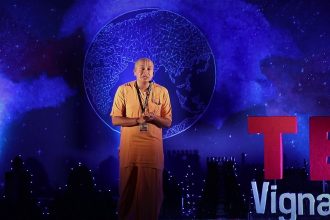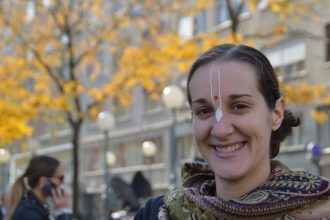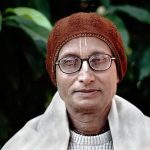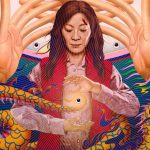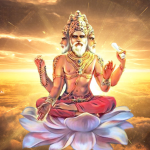Bhaktisiddhānta Sarasvatī Ṭhākura Gosvāmī Mahārāja Prabhupāda (1874-1937) the spiritual master of His Divine Grace A.C. Bhaktivedanta Swami Prabhupāda, and thus the spiritual grandfather of the present day Kṛṣṇa consciousness movement. A powerful preacher, he founded sixty four missions in India; The transcendentally empowered son of Śrīla Bhaktivinoda Ṭhākura, Śrīla Bhaktisiddhānta Sarasvatī Ṭhākura appeared in this world on February 6, 1874.
His father was deputy magistrate of Jagannātha Purī in Orissa at this time. Śrīla Bhaktivinoda Ṭhākura had been very concerned about unauthorized pseudo-Vaiṣṇavas who were usurping the pure teachings of Lord Caitanya Mahāprabhu, and therefore had begun a revival of the saṅkīrtana mission. Though very busy with his profession, he wrote profusely about all aspects of Kṛṣṇa consciousness.
He prayed constantly for someone to boldly preach his writings. Śrīla Bhaktivinoda Ṭhākura’s prayers were answered in Śrīla Bhaktisiddhānta Sarasvatī Ṭhākura. When he was six months old, the Ratha-yātrā festival of chariots was held in Purī. Lord Jagannātha’s chariot stopped in front of Śrīla Bhaktivinoda’s house, which was on the main road between the temple and the Guṇḍicā mandira.
The chariot stayed there for three days. On the third day, Śrīla Bhaktisiddhānta’s mother brought the child out to see the Lord. The pūjārīs picked him up and put him on the cart. He crawled to the base of Lord Jagannātha, touching His lotus feet. Simultaneously a garland fell from the neck of the Lord and landed around the child. The pūjārīs exclaimed that this child was especially blessed by the Lord. The boy grew up to be a great scholar in many fields of learning. But when he reached twenty-two, he left his studies at college, vowing to never take to householder life. For three years, Śrīla Bhaktisiddhānta Sarasvatī Ṭhākura held the post of rāja-pāṇḍita (royal scholar) of the Vaiṣṇava king of Tripura. Thereafter he took initiation from Śrīla Gaurakiśora dāsa Bābājī. Śrīla Gaurakiśora was a Vaiṣṇava renunciate who had fully absorbed himself in the worship of Kṛṣṇa at Vṛndāvana for a long time. Then he settled at the holy city of Navadvīpa on the bank of the Ganges. By this time Śrīla Bhaktivinoda Ṭhākura had retired from his government work and was worshiping Lord Kṛṣṇa in a small house near Navadvīpa, at Godruma. Every day he gave Śrīmad-Bhāgavatam class there.
Śrīla Gaurakiśora used to attend these classes. Śrīla Bhaktivinoda Ṭhākura told his son, Śrīla Bhaktisiddhānta Sarasvatī Ṭhākura, to accept Śrīla Gaurakiśora as his initiating spiritual master. He received the name Vārṣabhānavī-devī-dayitāya dāsa. Thereafter Śrīla Bhaktisiddhānta Sarasvatī Ṭhākura gave up all other activities to chant 194 rounds daily for seven years. He stayed in a kuṭira (hut) but did not take time to repair the roof; if it rained, he just used an umbrella. In 1918 he opened the first center of the Gauḍīya Mission in Ultadanga Road in Calcutta. He was then forty-four. All across India he established Lord Caitanya’s teachings as the most excellent spiritual philosophy. He started his mission in the midst of war and political agitation for national liberation. He was uncompromising in his disregard of such mundane concerns. The most important thing is to invoke the spirit of devotion to the Supreme Lord; this concern lies far above any material consideration.
Many leaders objected that he was diverting too many young men from India’s national interests, but he paid them no heed. In this period, Śrīla A.C. Bhaktivedanta Swami Prabhupāda visited Śrīla Bhaktisiddhānta Sarasvatī Ṭhākura on the rooftop at Ultadanga Road. Śrīla Prabhupāda, at that time known as Abhay Caran De, was an adherent of Gandhi’s svarāja movement. Śrīla Bhaktisiddhānta Sarasvatī Ṭhākura convinced him in just one sitting of the vital necessity of Lord Caitanya’s mission over everything else. Śrīla Bhaktisiddhānta Sarasvatī Ṭhākura departed this world in 1936. Two weeks before leaving his body, he instructed Śrīla Prabhupāda to introduce the saṅkīrtana mission to the Western world. See Bhaktivedanta Swami Prabhupāda, Bhaktivinoda Ṭhākura, Caitanya Mahāprabhu, Kṛṣṇa.
Bhaktivedanta Swami Prabhupāda His Divine Grace A.C. Bhaktivedanta Swami Prabhupāda is the foremost Vaiṣṇava ācārya in the modern age. In 1896, he appeared in this world as Abhay Caran De in Calcutta, where he received an English-language education. He first met his spiritual master, Śrīla Bhaktisiddhānta Sarasvatī Ṭhākura, in 1922. At their first meeting, Śrīla Bhaktisiddhānta Sarasvatī Ṭhākura requested Śrīla Prabhupāda to broadcast Vedic knowledge through the English language. In 1933, Śrīla Bhaktisiddhānta Sarasvatī Ṭhākura initiated Śrīla Prabhupāda as Abhaya Caraṇāravinda dāsa. In the years that followed, he wrote a commentary on the Bhagavad-gītā, assisted the Gauḍīya Mission in its work, and in 1944 started Back to Godhead, an English fortnightly magazine, still continued by his disciples today.
He received the title Bhaktivedanta in 1947 from the Gauḍīya Vaiṣṇava Society. In the 1950’s, Śrīla Prabhupāda retired from family life, accepting the vānaprastha order. Thus he was able to devote more time to his studies and writing. He came to Vṛndāvana to live humbly at the historic medieval temple of Rādhā-Dāmodara. After several years of deep absorption in Kṛṣṇa consciousness, Śrīla Prabhupāda accepted the order of sannyāsa from his Godbrother Keśava Prajña Mahārāja, in 1959. It was then that he began to work on his life’s masterpiece: a multivolume translation of and commentary on the eighteen-thousand verse Śrīmad-Bhāgavatam. After publishing three volumes of the Bhāgavatam in India, Śrīla Prabhupāda came to the United States in 1965. After great difficulty, with no initial financial resources, he established the International Society for Krishna Consciousness (ISKCON) in New York in July, 1966.
The residents of that great metropolis of materialism were astounded as the youthful American followers of Śrīla Prabhu-pāda danced and chanted the Hare Kṛṣṇa mahā-mantra in their midst, that eternal Vedic sound echoing between the glass and steel skyscraper canyon walls. The Kṛṣṇa consciousness movement soon spread to San Francisco, where the Ratha-yātrā festival of the chariots was held for the first time outside of India. A group of American disciples started a branch in London, where George Harrison of the Beatles became a life-long follower of Śrīla Prabhupāda. From England the movement went to Germany, Holland, France, and other European countries. It likewise flourished in Canada, Latin America, Australia and Africa. Simultaneously, Śrīla Prabhupāda personally established several multi-million-dollar ISKCON temple and guesthouse projects in India at Bombay, Vṛndāvana, Mayapur and Hyderabad. But Śrīla Prabhupāda considered his most significant contribution to be his books, which form a veritable library of Vedic philosophy, religion, culture and literature. Highly respected by the academic community for their authority, depth and clarity, they serve as standard textbooks in numerous college courses.
His writings have been translated into more than eighty languages. The Bhaktivedanta Book Trust, established in 1972 to publish his works, is the world’s largest publisher in the field of Vedic studies. In the twelve years after his first arrival in America up to his departure from this world in 1977, Śrīla Prabhupāda circled the globe fourteen times on lecture tours that took him to six continents. Even in his physical absence, his great mission continues to move forward. With the collapse of the Soviet Empire that Śrīla Prabhupāda predicted during his 1972 visit to Moscow, Kṛṣṇa consciousness is vigorously blossoming throughout Eastern Europe, Russia, and the Far East. ISKCON’s Mayapur project is growing into a modern spiritual city on the bank of the holy Ganges. 1996, the year of Śrīla Prabhupāda’s centennial, saw the opening of grand temple projects in Delhi, Bangalore and Baroda. See Bhaktisiddhānta Sarasvatī Ṭhākura, Bhaktivinoda Ṭhākura, Caitanya Mahāprabhu, ISKCON, Kṛṣṇa.




